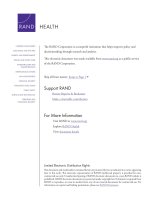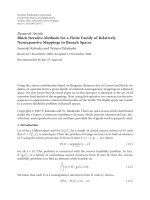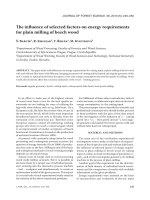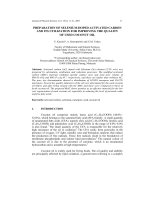Research Gaps and Measurement Challenges for Studying the Influence of New Media on Adolescent Sexual Health docx
Bạn đang xem bản rút gọn của tài liệu. Xem và tải ngay bản đầy đủ của tài liệu tại đây (241.11 KB, 13 trang )
For More Information
Visit RAND at www.rand.org
Explore RAND Health
View document details
Support RAND
Browse Reports & Bookstore
Make a charitable contribution
Limited Electronic Distribution Rights
is document and trademark(s) contained herein are protected by law as indicated in a notice appearing
later in this work. is electronic representation of RAND intellectual property is provided for non-
commercial use only. Unauthorized posting of RAND electronic documents to a non-RAND website is
prohibited. RAND electronic documents are protected under copyright law. Permission is required from
RAND to reproduce, or reuse in another form, any of our research documents for commercial use. For
information on reprint and linking permissions, please see RAND Permissions.
Skip all front matter: Jump to Page 16
e RAND Corporation is a nonprot institution that helps improve policy and
decisionmaking through research and analysis.
is electronic document was made available from www.rand.org as a public service
of the RAND Corporation.
CHILDREN AND FAMILIES
EDUCATION AND THE ARTS
ENERGY AND ENVIRONMENT
HEALTH AND HEALTH CARE
INFRASTRUCTURE AND
TRANSPORTATION
INTERNATIONAL AFFAIRS
LAW AND BUSINESS
NATIONAL SECURITY
POPULATION AND AGING
PUBLIC SAFETY
SCIENCE AND TECHNOLOGY
TERRORISM AND
HOMELAND SECURITY
This product is part of the RAND Corporation conference proceedings series. RAND
conference proceedings present a collection of papers delivered at a conference or a
summary of the conference. The material herein has been vetted by the conference
attendees and both the introduction and the post-conference material have been re-
viewed and approved for publication by the sponsoring research unit at RAND.
Research Gaps and
Measurement Challenges
for Studying the Influence
of New Media on
Adolescent Sexual Health
Steven Martino, Rebecca L. Collins, Rebecca Shaw
Sponsored by the U.S. Department of Health and Human Services
HEALTH
The research described in this report was sponsored by the U.S. Department of Health
and Human Services and was conducted in RAND Health, a division of the RAND
Corporation.
The RAND Corporation is a nonprofit institution that helps improve policy and
decisionmaking through research and analysis. RAND’s publications do not necessarily
reflect the opinions of its research clients and sponsors.
R
®
is a registered trademark.
© Copyright 2012 RAND Corporation
Permission is given to duplicate this document for personal use only, as long as it
is unaltered and complete. Copies may not be duplicated for commercial purposes.
Unauthorized posting of RAND documents to a non-RAND website is prohibited. RAND
documents are protected under copyright law. For information on reprint and linking
permissions, please visit the RAND permissions page (
permissions.html).
Published 2012 by the RAND Corporation
1776 Main Street, P.O. Box 2138, Santa Monica, CA 90407-2138
1200 South Hayes Street, Arlington, VA 22202-5050
4570 Fifth Avenue, Suite 600, Pittsburgh, PA 15213-2665
RAND URL:
To order RAND documents or to obtain additional information, contact
Distribution Services: Telephone: (310) 451-7002;
Fax: (310) 451-6915; Email:
2
Preface
The expert panel meetings summarized in this document were conducted under contract
HSP23320095649WC, Task Order No. HHSP23337005T, with the Administration for Children
and Families (ACF) and the Office of the Assistant Secretary for Planning and Evaluation
(ASPE) within the U.S. Department of Health and Human Services. The goal of the task order is
to develop a working knowledge base about the use of new media (such as the Internet, social
networking sites, cell phones, online video games, and MP3 players) among adolescents and the
potential impact on their sexual health and to identify appropriate measures for assessing this
use, thus setting the stage for future research and intervention.
On March 2, 2011, an expert panel was convened at the RAND Corporation offices in Arlington,
Virginia. Follow-up telephone conferences were held with panelists on April 6, 2011, and April
11, 2011. The panel consisted of 15 individuals—three from RAND and twelve from other
institutions (see the list of panelists at the end of the document). Their combined expertise
encompasses the areas of media use and its measurement (particularly new media), adolescent
sexual health, and media effects on adolescent health. Panelists included experts in the use of
new media in sexual health interventions, as well as in identifying and testing the unintended
effects of exposure to new media on sexual health. Additional experts, representatives of various
government agencies and stakeholders, attended the March 2 meeting and participated in the
discussion.
The meeting summary contained herein summarizes the discussion during that in-person meeting
and two follow-up conference calls. We have focused this summary on areas where there was
consensus expressed among panelists, but readers should not assume that all panelists endorsed
all of the ideas and conclusions presented here. The intended audiences for this meeting
summary are policymakers, research funders, public health professionals, researchers studying
adolescent sexual health and media use, and program developers.
This research was conducted in RAND Health, a division of the RAND Corporation. A profile of
RAND Health, abstracts of its publications, and ordering information can be found at
www.rand.org/health.
3
Research Gaps and Measurement Challenges for Studying
the Influence of New Media on Adolescent Sexual Health
The goals of the meeting were (1) to identify gaps and priorities for future research in the area of
new media use and its links to adolescent sexual health and (2) to discuss measurement and
design issues with an eye to the development of valid and reliable measures of adolescent new
media use that might be helpful in the study and promotion of adolescent sexual health. The
panel’s discussion can be roughly categorized into two overarching topics: theoretical issues and
measurement challenges. Below, we summarize the points raised and conclusions or suggestions
made by panelists in each of these areas in turn beginning with the topic of theory. The main
points of discussion are numbered and shown in bold. Each of these points is followed by a brief
synopsis of the conversation that took place surrounding it (the text that is not in boldface type).
The numbered sections then end with the final conclusion reached by the panel on a particular
topic or point, shown in bold.
Theoretical Approaches to the Study of New Media and Adolescent Health
1. We need to understand what is new about “new media” and what we mean by this
term.
There is an urgent need for the field to define the distinct features of new technologies and
applications that are of greatest theoretical and practical interest. We agreed that “new media” is
an insufficient term for describing the vast array of technologies, applications, and activities in
which we are interested. This term is likely to become outdated quickly, and reliance on this term
keeps us from carefully considering both the ways in which youth use digital media and the
features of new technologies and applications that may drive their effects on sexual development.
The key features of new media that distinguish them from old (vintage) media are that they
are social, interactive, malleable, and portable (mobile). The implications of these
differences in terms of the effects new media might have on youth sexual behavior and
health have yet to be examined by research.
2. Although there are similarities between online and offline life, there are also key
differences that limit the usefulness of existing theories.
We acknowledged that existing theories for understanding such processes as peer influence, self-
presentation, and relationship formation are somewhat suitable for understanding new media
processes of interest. We also agreed that there are important ways in which these processes
unfold differently online compared with offline. For example, we discussed how interacting with
friends, relationship partners, and health professionals around the topics of sex and sexuality
through instant messaging and blogs is likely to be different from interacting in person because
of the social distance that media afford. That is, people may feel more comfortable talking about
sensitive topics and express themselves more freely. On the one hand, this social distance may
thus lead to frank and helpful discussions of sexual health issues. On the other hand, it may lead
to inappropriate or ill-advised disclosure of intimate information or feelings (as in some cases of
sexting) or to sexually aggressive or hostile interactions such as those evidenced by
cyberbullying. We also talked about how the anonymity that the Internet affords can lead people
to say things that they otherwise would not say. Finally, we talked about how online efforts to
4
negotiate one’s identity or reputation may be different and have different consequences from the
same sort of efforts made offline. Important aspects of new media that may alter the experience
of social interaction and the distribution of information are that (1) its use affords psychological
distance, (2) communication often happens asynchronously, (3) digital material can be edited and
reproduced, (4) a record of communication and interaction persists, and (5) interaction through
the Internet is highly public. The portability of new media has at least two implications: Youth
can be connected almost continuously (“anytime” access), and youth interact with media in
newer and more varied contexts (“anywhere” access). Anytime access means that youth may
consume more of new media than traditional media and do so in response to the situations that
come up in their daily lives. A youth might access the Internet to answer a question of immediate
importance, such as the closest place to purchase a condom or get an STD test. Anywhere access
encourages much more media multitasking than was possible with traditional media. This means
that youth may be more (or less) affected by media content because their attention is also focused
on other activities, such as shopping, or other media. New or revised theories need to take these
aspects of portability into account, since they may moderate the effects of media exposure and
media-based sexual health intervention on youth sexual health outcomes.
Although many of these aspects of new media and their potential effects on behavior can be
derived from existing theories of behavior outside the media realm (for example, psychology or
public health), the panel felt that most such theories were either too broad to provide these kinds
of specific predictions (for example, the Theory of Reasoned Action) or were too specific to
account for the variety of predictions that could be made regarding new media (for example,
theories of social distancing).
Existing theories from the fields of psychology, public health, and communication are
useful in understanding new media effects but need to be integrated and expanded to more
fully capture new media processes and better predict and explain effects.
3. Little research or theorizing has been done to understand the significance of how
youth process others’ reactions to media content (e.g., on video-sharing sites, social
networking sites, and blogs).
This is related to the preceding point but is more specifically focused on how the effects of
media content (e.g., a video on YouTube) may depend on the type of reactions to it that appear
online (e.g., the comments and “likes/dislikes” that appear below the video on YouTube). Social
interaction surrounding media is referred to in the communications field as “social mediation.” It
is has been found to alter the effects of exposure to media content. Social mediation of media
effects happens with traditional media as well but typically among a small group of known
others (e.g., parents, close friends). Moreover, whereas traditional media content is meant to be
consumed as is, user-generated new media often call for response and manipulation by users.
That is, the user response is as much a part of the media as the original content itself. This
feature of new media likely amplifies the importance of peers in mediating the effects of
exposure to media content.
New media theories must account for the heightened role of social mediation in new media.
5
Measurement
4. Existing measures of media use are inadequate for understanding the effects of new
media because they do not capture the interactive and dynamic aspects of new media.
Our measures of new media use tend to provide a single snapshot of media use, which may be
insufficient for understanding the effects of dynamic and interactive processes. Some studies
look at the effects of experimental exposure to one episode of a television show versus another.
Others look at, for example, associations between the sexual content seen during a television
season and subsequent initiation of intercourse. One of the latter studies asked youth to report on
the programs they watched and then content-coded these programs to count the number of scenes
with sexual content in them. Tests were conducted to see if researchers could differentiate the
later sexual behavior of youth based on the number of sex scenes in the content they watched.
The content of programs already aired cannot change—the measure used in this study was thus a
“snapshot” of the past but was adequate to answer the question of how television content might
influence youth. In contrast, the content of online and other new media can change and can do so
in response to others’ feedback. For example, the panel talked about how a person may make a
statement on Facebook or post a picture there to see what type of reaction it gets and then modify
subsequent self-presentations based on that reaction. The panel also talked about how media are
sometimes created by youth and then manipulated (e.g., reproduced or commented upon) by
others over time. A picture that originally depicted a casual kiss might be altered to make it
appear that more sexualized behavior took place. Thus, to understand the effects of the media, it
is important to understand how these media evolve and to collect multiple assessments of them
over time.
Measures of new media must capture the dynamism and interactive nature of media as
currently experienced by youth.
5. Survey questions about use of new technologies and applications may not always be
interpreted by youth in a way that is consistent with the intent of researchers.
We wondered whether a question about exposure to sexual content might be interpreted by youth
more narrowly than we intend. In particular, we wondered whether youth would consider content
that they generate or read (e.g., comments left on Facebook walls, comments they read on
YouTube) as media content and think about it when responding to a question about sexual
content. The panel agreed that such comments would be sexual content and youth should include
them in responding to questions about exposure. We also talked about the tension between
wanting to create questions that refer to general phenomena and activities and the need to cite
specific examples to make the questions concrete. For example, we talked about the problems
involved in using the term “microblogging site” to ask about such applications as Twitter. Many
youth may not understand the term “microblogging” or realize that Twitter is an example of it.
We also discussed how some youth responded with “YouTube” and some adults responded with
“Twitter” when asked on recent Pew Internet and American Life surveys to list the social
networking sites on which they had profiles. Finally, we talked about how some youth
interpreted a question about use of the Internet to get information about sexual health to mean
accessing sexual content more broadly online.
In posing questions about new media use, it may be necessary to both refer to the general
phenomenon and give specific examples (e.g., refer to “microblogging sites such as
6
Twitter”). The wording of these questions may need to change as the technologies and their
use change.
6. In designing surveys, questions about media use should be framed in terms of content
and applications rather than platforms or devices unless hypotheses are platform- or
device-related.
The lines between a device, a platform, and an application are somewhat fuzzy as these terms are
commonly used. For example, “television” does not refer to a medium or to the content of the
medium, but rather, to a device (platform) used to watch screen media. Historically, research
questions were posed about the effects of television on youth behavior. At the time, television
programming could be viewed only on a television set, and the programming offered was fairly
uniform in content. As a result, researchers could ask a survey question of youth such as how
much time they spent watching television (a platform question) and predict behaviors such as
aggression from the responses they got. Today, televisions air “movies” as well as programming
designed specifically for the television platform, and the content offered on televisions is
extremely diverse. Moreover, “television” content can be watched on computers, cell phones,
and other handheld devices. Thus, a survey question about the amount of time spent watching
television might be hard for a study participant to understand. The respondent might wonder
whether or not to include television programming watched on a computer, for example.
A media application, also known as application software or an “app,” is computer software that
allows a user to perform a specific task or tasks. Applications can be categorized in many ways,
but some of the most common categories are social applications such as Facebook and Twitter,
news and information applications, games, and shopping applications such as eBay. Application
software is contrasted with system software, which manages and integrates a computer's
capabilities but typically does not directly apply them in the performance of tasks.
Questions about use of media applications may be interpreted more easily by participants, and
yield more useful data, than questions about platforms. As an example, we discussed the
technology of text messaging, which used to be possible only through a cell phone but now is
supported by a variety of platforms. We agreed that media content and applications are of
primary research interest, and that it may therefore be simpler and more informative to leave
platforms out of our survey items altogether. However, we agreed that we may sometimes have
an interest in the effects of platforms that are independent of the effects of the content or
mediated activity itself; in those cases, it would be important to incorporate platforms in our
survey items.
Survey questions about media should be framed in terms of content (e.g., “How often do
you see something sexually explicit online?”) and applications (e.g., “In a typical day, how
much time do you spend on a social networking site like Facebook or MySpace?”) rather
than platforms (e.g., “How much time do you spend using a computer?”) unless hypotheses
are platform-related.
7. From a measurement standpoint, it may sometimes be useful to focus on the purposes
of youths’ media activities rather than on the specific platforms or applications they use.
We identified several purposes that may underlie youths’ new media use—including
communication, entertainment, information-gathering, persuasion, and self-presentation—and
considered whether asking about these purposes of use may sometimes be more useful than
7
questions about the amount or type of use of specific platforms and applications. An argument in
favor of this approach is that even though the technologies are likely to shift—and sometimes
shift rapidly—the purposes for which youth use mediating technologies are likely to remain
fairly constant. Although this approach may work for addressing certain hypotheses, however, it
is unlikely to work as a universal approach for answering questions about new media use.
Moreover, there is some concern that youth may not always have insight into the purpose or
purposes of their media use and so would not be able to provide reliable answers to questions
framed in this way.
Researchers should consider whether organizing measures by the purpose of use rather
than the amount or type of use would address their hypotheses.
8. There are compelling reasons to measure exposure to sexual content from the user’s
perspective; however, there are also some important potential drawbacks to this
approach.
We discussed the need to analyze the content of a website such as YouTube to get a sense of
how much sexual content it contains. The point was made that the scope of YouTube is so vast
that it would be impossible to link a measure of content to any particular individual. It was
suggested that a researcher could simply ask a child to self-report the amount of sexual content to
which he or she was exposed on YouTube recently (e.g., in the past 24 hours). Two panelists
discussed independent efforts to validate self-reported measures of exposure to sexual content in
which they found that simple self-reported measures were as predictive of changes in sexual
behavior as were more elaborate measures based on rigorous content analyses. A counterpoint
was made, however, about how such a self-reported measure would not capture “background”
exposures to which the youth paid little attention. This background exposure is important to the
extent that exposure that occurs outside awareness or under conditions of low attention has
implications for decision-making and behavior. The point was also made that asking youth to
self-report exposure to sexual content requires the assumption that respondents’ definitions of
sexual content match our definition. Content that is not overtly sexual (e.g., sexually suggestive
behavior such as physical flirting, or talk about sexuality) but that still conveys important
messages about sexuality may not be considered by teens as sexual content.
Self-reported exposure to sexual content may be sufficient but further evidence is needed to
validate such measures.
9. Retrospective self-reported measures of media use and exposure to sexual content are
valuable tools but have critical limitations.
We discussed the limitations of retrospective self-report measures of media use and exposure to
sexual content and agreed that more elaborate measures (e.g., daily diaries, ecological
momentary assessment, online tracking software, analysis of transcripts from online interactions,
Nielsen’s People Meter Technology) may sometimes be necessary for capturing uses and
exposures of which youth are less than fully aware or to which youth may not be inclined to
admit or be able to accurately report.
Methods other than retrospective self-reporting may be necessary for capturing media use
or exposure to sexual content that the researcher or the respondent may not be aware of or
exposures that youth may be embarrassed to admit.
8
10. Some key ethical issues arise specific to the study of youths’ online behavior. These
include the issues of respondent age and consent and what is allowed, given user
agreements on each site.
When youth participants are recruited online, it may be difficult to determine whom one is
enrolling in a study and to obtain their consent. We noted that consent is not always necessary,
since much of what is posted online is considered public behavior. However, we noted that not
all sites permit users to “scrape” data from other users (to directly download the information
shown rather than taking notes about it). A number of available resources were discussed to help
researchers with these issues. They include a recent book by Sheana Bull (with Mary McFarlane,
Technology Based Health Promotion, Thousand Oaks, Calif.: Sage, 2011), the Association of
Internet Researchers ethics website (!""#$%%&'"()'(")(*(+),!("!&,* )/%01and presentations by a
panel convened by the Secretary’s Advisory Committee on Human Research Protections
(available at1!""#$%%222-!!*-/.3%.!)#%*+,!)#%4"/&'/*%4"/56785%#)(*('"-!"490-
Some ethical issues unique to new media, as well as some resources available to assist with
these issues, should be carefully considered.
11. Experimental research (in the laboratory, as part of an online survey or a “directed
viewing” study) may be a better method of answering fine-grained questions regarding
the effects of sexual media content than correlational studies.
Panelists noted that experimental laboratory-based studies are better able to test the effects of
specific forms of sexual content (for example, sexual content depicting negative versus positive
consequences). Naturally occurring content may not provide sufficient examples of such material
to test the correlates of exposure using survey methods. Online experiments might involve
showing online youth specific content and surveying them (via the web) immediately after
exposure, or participants’ online behavior post-exposure might be assessed (e.g., commenting on
the material, clicking through to additional information, revisiting the site).
Experimental methods provide an important complement to correlational approaches to
testing the effects of new media use on adolescent sexual health.
12. We discussed whether a small set of key questions about media use exists that could
be usefully included on large multipurpose national surveys.
There are sometimes opportunities to include a small set of questions about media on large,
national surveys of youth, such as the National Children’s Study or surveys primarily designed to
address other questions. Ideas about these questions included ones to identify heavy media use,
the technology or application that youth engage with most often, the intensity of their
engagement with that technology or application, a broad question about exposure to sexual
content, a more specific question about exposure to sexually explicit material, and a question
about online sexual harassment. The panel agreed, however, that this list has important
limitations (see items 4, 6, 8, and 9, above, regarding these issues, including swift changes in
media applications and recall errors and biases).
It is a high priority to begin including a set of key questions about new media use on large,
national surveys. An interim set should be developed, but formative research to refine and
validate such measures is imperative.
9
13. Interactive electronic game-playing is an understudied topic in new media research
that is worthy of attention.
The implications of interactive electronic game-playing (e.g., networked console gaming,
massive multiplayer online gaming) for sexual development and behavior have rarely been
considered. Many youth now engage in networked console gaming and massive multiplayer
online gaming with headsets and voice-over technology. These games are often played with
people whom youth do not know or know only online and with whom they have no other
connection. There is anecdotal evidence that during the course of this gaming, players often
make sexist, racist, and other explicit and offensive comments that often have nothing to do with
the game being played. There has been almost no research on these types of gaming, although
they are played by a significant portion of youth.
Interactive game-playing is a popular online activity that may have important implications
for sexual development and behavior; more research is needed to determine if there are
areas of concern or opportunities for intervention.
14. The top priority area for new or continued new media research is social
media, including but not limited to social networking sites, video-sharing
and video-viewing sites.
Social media are the top priority for future research. Social media include many interactive game
sites but also social networking sites and video-sharing and video-viewing sites such as
YouTube. It may also include sites focused on live streaming video (such as USTREAM) and
video chat enabled by web cams. Although there are a few existing studies addressing sexual
content in social media, researchers are far from an understanding of the amount and types of
sexual content to which youth are exposed through these media. Most important, there are strong
reasons to expect that social media use might have different, probably stronger, effects on youth
attitudes and behavior than traditional media use. Unlike traditional media, social media
incorporate a variety of tools to support public or semi-public interactions between participants.
These tools allow individuals to surround themselves instantly with the online representations of
friends, acquaintances, and like-minded others, providing frequent opportunities for virtual
socialization. Decades of research have highlighted the crucial role of adolescents’ peers in the
development of sexuality and identity. This role is likely to be amplified online as youth interact
under the conditions that social media afford—e.g., social distance and the opportunity to reach a
large audience easily. For example, a sexually inexperienced teen may post a sexual message on
his or her social networking profile to appear mature or to make a joke. Once he or she observes
his or her own actions, and particularly if other people’s reactions reinforce the teen’s sexualized
behavior, the teen may shift to see him or herself as sexually mature or as a sexual object.
These key features of social media have not been tested to determine how they might increase or
decrease the potential for media effects on sexual health. Research is needed that tests social
media as a tool for improving adolescent sexual health. Research examining the unintended
effects of social media use on youth sexual health is also a top priority.
Studies of the effects of social media are the top priority for research in the
area of new media and adolescent sexual health.
10
Panelists
Outside Panelists
Jane Brown, PhD – University of North Carolina–Chapel Hill
Ralph DiClemente, PhD – Emory University
Amy Beth Jordan, PhD – University of Pennsylvania
Amanda Lenhart, MA – Pew Research Center
Deb Levine, MA – Internet Sexuality Information Services, Inc., Oakland, Calif.
Megan Moreno, MD, MSEd, MPH – University of Wisconsin–Madison
Seth Noar, PhD – University of Kentucky
Michael Rich, MD, MPH – Children's Hospital Boston
Vicky Rideout, MA – VJR Consulting, San Francisco, Calif.
Kaveri Subrahmanyam, PhD – California State University Los Angeles
Susan Tortolero, PhD – University of Texas
Monique Ward, PhD – University of Michigan
RAND Panelists and Presenters
Rebecca Collins, PhD
David Kanouse, PhD
Steven Martino, PhD









